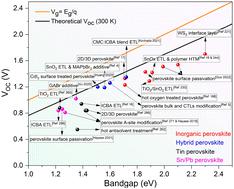当前位置:
X-MOL 学术
›
Energy Environ. Sci.
›
论文详情
Our official English website, www.x-mol.net, welcomes your
feedback! (Note: you will need to create a separate account there.)
The high open-circuit voltage of perovskite solar cells: a review
Energy & Environmental Science ( IF 32.4 ) Pub Date : 2022-06-20 , DOI: 10.1039/d2ee00663d Zhanglin Guo 1 , Ajay Kumar Jena 1 , Gyu Min Kim 2 , Tsutomu Miyasaka 1
Energy & Environmental Science ( IF 32.4 ) Pub Date : 2022-06-20 , DOI: 10.1039/d2ee00663d Zhanglin Guo 1 , Ajay Kumar Jena 1 , Gyu Min Kim 2 , Tsutomu Miyasaka 1
Affiliation

|
Perovskite solar cells (PSCs) have made incredibly fast progress in the past years, with the efficiency approaching 26%, which is comparable to those of the best silicon solar cells. One of the features of PSCs that make them stand out among all photovoltaics (PVs) is their high open-circuit voltage (VOC) although they are made by solution processes. Compared to other solution-processed PVs such as organic photovoltaics and dye-sensitized solar cells, and vacuum-processed PVs like CdTe and CIGS, the loss in VOC caused by non-radiative recombination in the case of PSCs is considerably low, which is even as low as that observed for vacuum-processed Si. The defect-tolerant nature of perovskites helps in preventing non-radiative recombination and therefore yields high VOC in PSCs. By comparing the achieved performance with the Shockley–Queisser (S–Q) limits, it can be determined that while the photocurrent of PSCs reaches almost the theoretical limit, there is still room to improve the VOC, especially in the case of all-inorganic and tin-based perovskites. Hence, improving the VOC becomes critical for promoting device efficiency further. In this review paper, we focus our discussion on the recent development of VOC of PSCs by beginning with a theoretical review highlighting the critical role of VOC enhancement and the necessity of non-radiative recombination suppression for device performance improvement. As the recombination both in the bulk of the perovskite and on the surface/interfaces with charge transport layers is important, different methods depending on the perovskite composition and the nature of the electron transport layer (ETL) and hole transport material (HTM) have been developed to minimize recombination in the perovskite and at the interfaces. We provide a comprehensive review of different reported strategies for reducing undesirable recombination in the perovskite film and at the interfaces, by dividing our discussion into four parts based on the light absorbers used: organic–inorganic hybrid perovskites, all-inorganic perovskites, tin-based perovskites, and bismuth-based perovskites (analogs). Finally, a summary with an outlook on how reducing perovskite film defects and developing more suitable charge transport layers can further promote the VOC and expand the practical application prospects of PSCs is presented.
中文翻译:

钙钛矿太阳能电池的高开路电压:综述
钙钛矿太阳能电池 (PSC) 在过去几年中取得了令人难以置信的快速发展,效率接近 26%,与最好的硅太阳能电池相当。PSC 使它们在所有光伏 (PV) 中脱颖而出的特性之一是它们的高开路电压 ( V OC ),尽管它们是通过溶液工艺制成的。与其他溶液处理的 PV(如有机光伏和染料敏化太阳能电池)以及真空处理的 PV(如 CdTe 和 CIGS)相比,V OC的损失在 PSC 的情况下,由非辐射复合引起的现象相当低,甚至与真空处理的 Si 观察到的一样低。钙钛矿的容错性有助于防止非辐射复合,因此在 PSC 中产生高V OC 。通过将实现的性能与 Shockley-Queisser (S-Q) 限制进行比较,可以确定虽然 PSC 的光电流几乎达到了理论限制,但V OC仍有提高的空间,尤其是在所有-无机和锡基钙钛矿。因此,提高V OC对进一步提高器件效率至关重要。在这篇评论文章中,我们将重点讨论V的最新发展PSC 的OC ,从强调V OC关键作用的理论回顾开始增强和非辐射复合抑制对器件性能改进的必要性。由于钙钛矿主体和与电荷传输层的表面/界面上的复合很重要,因此根据钙钛矿成分和电子传输层 (ETL) 和空穴传输材料 (HTM) 的性质的不同方法已经开发以最大限度地减少钙钛矿和界面处的复合。我们根据所使用的光吸收剂将我们的讨论分为四个部分:有机-无机杂化钙钛矿、全无机钙钛矿、锡基钙钛矿和铋基钙钛矿(类似物)。最后,介绍了VOCs和拓展PSCs的实际应用前景。
更新日期:2022-06-20
中文翻译:

钙钛矿太阳能电池的高开路电压:综述
钙钛矿太阳能电池 (PSC) 在过去几年中取得了令人难以置信的快速发展,效率接近 26%,与最好的硅太阳能电池相当。PSC 使它们在所有光伏 (PV) 中脱颖而出的特性之一是它们的高开路电压 ( V OC ),尽管它们是通过溶液工艺制成的。与其他溶液处理的 PV(如有机光伏和染料敏化太阳能电池)以及真空处理的 PV(如 CdTe 和 CIGS)相比,V OC的损失在 PSC 的情况下,由非辐射复合引起的现象相当低,甚至与真空处理的 Si 观察到的一样低。钙钛矿的容错性有助于防止非辐射复合,因此在 PSC 中产生高V OC 。通过将实现的性能与 Shockley-Queisser (S-Q) 限制进行比较,可以确定虽然 PSC 的光电流几乎达到了理论限制,但V OC仍有提高的空间,尤其是在所有-无机和锡基钙钛矿。因此,提高V OC对进一步提高器件效率至关重要。在这篇评论文章中,我们将重点讨论V的最新发展PSC 的OC ,从强调V OC关键作用的理论回顾开始增强和非辐射复合抑制对器件性能改进的必要性。由于钙钛矿主体和与电荷传输层的表面/界面上的复合很重要,因此根据钙钛矿成分和电子传输层 (ETL) 和空穴传输材料 (HTM) 的性质的不同方法已经开发以最大限度地减少钙钛矿和界面处的复合。我们根据所使用的光吸收剂将我们的讨论分为四个部分:有机-无机杂化钙钛矿、全无机钙钛矿、锡基钙钛矿和铋基钙钛矿(类似物)。最后,介绍了VOCs和拓展PSCs的实际应用前景。











































 京公网安备 11010802027423号
京公网安备 11010802027423号